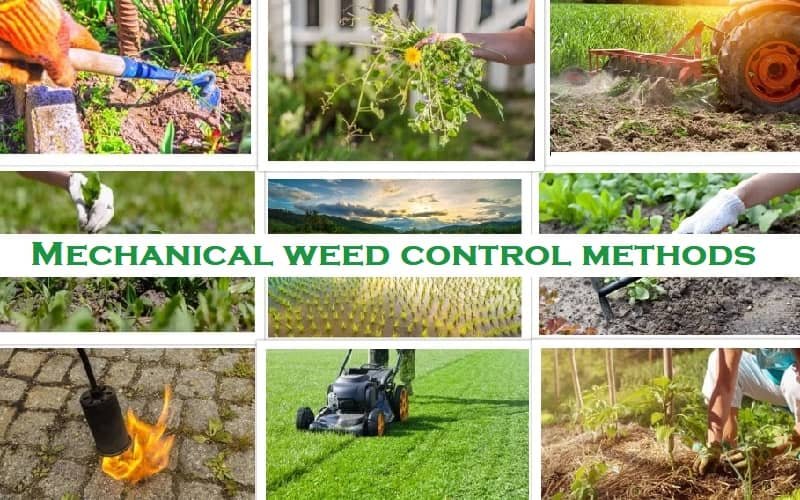What Are The Benefits Of Using Organic Weed Control Methods In The Garden?
As the world becomes more concerned with environmental sustainability and organic farming, there is a growing trend of farmers turning to mechanical weed control methods instead of chemical herbicides. These methods offer numerous benefits, but also come with their own set of drawbacks. In this post, we will explore the top 8 mechanical weed control methods, their merits, and their demerits.

1. Hand Weeding
Hand weeding is perhaps the oldest and most widely used mechanical weed control method. This method involves manually removing weeds by hand, usually with a hoe or other simple tool. One of the main advantages of this method is that it is highly selective, meaning it only targets the weeds and not the surrounding crops.
However, hand weeding can be a time-consuming and labor-intensive process, especially on large farms. Additionally, it is not always 100% effective, as it can be difficult to remove all of the weed roots without damaging the surrounding crops.
2. Flame Weeding
Flame weeding involves using a propane torch or other heat source to burn the weeds, effectively killing them. This method is particularly effective on young weeds, as they have not yet developed deep roots.
One advantage of flame weeding is that it can be done quickly and efficiently, even on large farms. Additionally, it does not require the use of any chemicals. However, flame weeding can be dangerous, as the heat source can easily ignite nearby vegetation. It also requires specialized equipment, which can be expensive.
3. Mulching
Mulching involves covering the soil around crops with a layer of mulch, such as straw, leaves, or bark. This layer of mulch helps to suppress weed growth by blocking sunlight from reaching the soil.
Mulching is a relatively simple and inexpensive method of weed control, and it also provides other benefits such as moisture retention and soil temperature regulation. However, it is not effective on all types of weeds, and it can pose a fire hazard if the mulch becomes too dry.
4. Cultivation
Cultivation involves using a hoe or other mechanical tool to physically disturb the soil around crops, uprooting weeds in the process. This method is best used on larger crops, such as corn and soybeans.
One advantage of cultivation is that it is relatively inexpensive and does not require the use of any chemicals. However, it can be time-consuming and can also damage the nearby crops if not done carefully.
5. Mowing or Cutting
Mowing or cutting involves using a lawnmower or other mechanical device to cut the tops off weeds, effectively removing them from the soil. This method is particularly effective on tall weeds, such as thistles and hogweed.
Mowing or cutting is a quick and easy way to control weeds, but it is not always effective, as it only removes the tops of the weeds and not the roots. Additionally, it can be difficult to spot individual weeds amongst the surrounding crops.
6. Grazing
Grazing involves allowing livestock to feed on crops and weeds, effectively controlling weed growth. This method is particularly effective on large, open pastures and rangelands.
One advantage of grazing is that it can be a relatively inexpensive way to control weeds, as it does not require the use of any specialized equipment. Additionally, it provides a source of food for the livestock. However, it is not practical for all types of crops, and can be difficult to manage if not done carefully.
7. Cover Crops
Cover crops involve planting a low-growing crop, such as clover or rye, alongside the main crop. The cover crop helps to suppress weed growth by blocking sunlight and using up soil nutrients.
Cover crops provide numerous benefits in addition to weed control, such as soil improvement and erosion prevention. However, they can be difficult to manage, and certain cover crops may not be suitable for all types of soil and crops.
8. Solarization
Solarization involves covering the soil around crops with clear plastic, effectively trapping the heat and moisture underneath. This heat and moisture help to kill off weeds and other pests.
One advantage of solarization is that it is a relatively simple and inexpensive method of weed control, and it does not require the use of any chemicals. However, it can be difficult to implement on a large scale, and it may not be effective in all types of soil and climates.
Conclusion
As we have seen, mechanical weed control methods offer numerous benefits over chemical herbicides, including environmental sustainability, crop selectivity, and cost-effectiveness. However, they also come with their own set of drawbacks, such as labor-intensiveness, limited effectiveness, and the need for specialized equipment.
Ultimately, the best method of weed control will depend on a variety of factors, including crop type, soil conditions, and available resources. By carefully evaluating these factors and selecting the appropriate mechanical weed control method, farmers can improve the health and productivity of their crops while also promoting environmental sustainability and organic farming practices.



